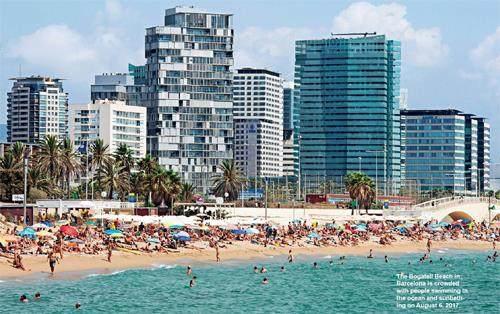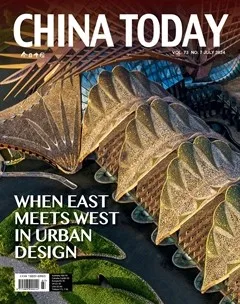Waterfront Space Injects Life to Urban Development:Shanghai and Barcelona
TIAN WEIJIA

WATER has always played a vital rolein the birth and progress of humancivilization, whether it was in theMesopotamia, the Nile Valley or theYellow River basin. Water was not only helpful insolving the problems of irrigation, drinking, and sewage disposal of cities that existed in ancienttimes, but also offered a means of transportation,an important basis for the development of civilizationin the Mediterranean region.
However, with urban development and changingneeds of urban dwellers today, the relationshipbetween humans and water has becomeincreasingly complex. Trending changes in thewaterfront cityscape can give us a glimpse intothe ups and downs that cities are going through.Shanghai in China and Barcelona in Spain benefitfrom water resources from the river and the sea,respectively. Nevertheless, their urban developmentis characterized by a similar relationshipwith water.
Emerald of the Mediterranean
The peaceful Mediterranean gave birth to theearliest seamanship in human history. Barcelonais a city founded by the Phoenicians when theyexplored the Mediterranean from the west to theeast in before-Christ days.
Barcelona developed into city scale when the Roman Empire dominated the Mediterranean. At the time, city walls kept Barcelona from coastalareas to defend it against enemy attacks fromthe sea. People could only enter the city throughthe city gates. Although the city was expanded,the defensive function of the city walls remainedunchanged.
During the ruling of the King of Aragon in the14th century, Barcelona boasted the most powerfulnaval marina at that time. Artillery becamethe main weapon for maritime warfare. Barcelonabuilt two military fortresses on its two flanks.Like the pincers of crabs, the military fortresseswell protected the city.
Barcelona ushered in rapid development whenthe Industrial Revolution began. Unable to finda shelter in downtown areas, numerous migrantworkers had to gather outside the city walls in thepeninsula of the Mediterranean. The peninsulabore the brunt of war, but thanks to its proximityto the sea, the area, known as Barceloneta, quicklyemerged as a popular gathering place for workersand fishermen.
Barcelona demolished its city walls in 1854,and the world-famous Cerda Plan was brought up.The city began to expand inland, and the coastalarea of Barceloneta gained prominence thanks toconvenient transportation on the Mediterranean.It was also during this period that the citys firstrailway opened to traffic in the coastal area. All ofthis made it a prime choice for setting up factories.
In 1932, Le Corbusier, an internationally influentialSwiss architect and city planner, was invitedby the Group of Catalan Architects and Techniciansfor the Progress of Contemporary Architecture(GATCPAC) to design for the development ofBarcelonas coastal area. Corbusier presented PlanMacia, the first contemporary plan for industrybaseddevelopment of a coastal area, as well as thefirst urban plan to address the need of the middleclass for seaside vacations. The plan tried to turnthe seaside area into a public space and integrateit into the structure of the city. Unfortunately, underthe dictatorship of Francisco Franco, the planto renovate Barcelona's coastal area was shelved.In the ensuing decades, the area plunged into aslum.
Spains economic take-off and the recovery of international tourism in the 1970s revitalized Barcelona'scoastal area. Convenient transportation,pleasant climate and quality sandy beach made it apopular tourist destination for people in northernEurope. At the time, the slum was demolished, andthe coastal area began to gradually transition froman industrial area to a tourist destination.
Barcelonas win in the bid for the OlympicGames in 1986 ushered in a round of comprehensiveupgrading of the coastal area. The most importantmeasures were the building of the seasidesunken ring road and the renovation of the formerindustrial zone based on the Olympic Village.
The former solved the problemof accessibility for residentsof the entire area. Thesunken ring road maintainedthe elegant coastal skyline. Inthe renovation, a number ofhigh-quality residential compoundswere built. The buildingswhere journalists and athletes stayed during the 1992 Barcelona OlympicGames were designed as commercial housing inthe first place.
At the seaside end of the Olympic Village aretwo twin towers, which are as high as high-risesenvisioned in the Plan Macia. In post-Olympictimes, the twin towers emerged as a center ofrestaurants, hotels and casinos. With the influenceof the Olympic Games and urban renewal efforts,Barcelona became one of the most popular highendtourist cities in the world. In 2000, the citywelcomed seven million tourist arrivals.
The increase in tourists has driven the continuousadjustment of regional business. Rounds offeasibility study on relocating businesses in thelarge port in the southwest were carried out, butthe city doesnt decide on whether to keep theport or renovate it into an international businessdistrict. The coastal area in the northeast continuedthe momentum of the Olympic Village, but itdidnt develop into a core tourism area as planned.Businesses in the area have been navigating from the tourism sector into cultural, convention andexhibition sectors. Local residents are replacingtourists in using the waterfront space.
Pearl of the Huangpu River
Geographically, Shanghai is located in theTaihu Lake Basin area. The Wusong River (nowSuzhou River), one of the three rivers that flowedthrough the ancient Taihu Lake area, was the lasttributary of the Yangtze River before it joins thesea. After a large-scale water conservancy projectthat was conducted during the early 15th century,the Wusong River changed from being a tributaryof the Yangtze River to being a tributary ofthe Huangpu River. Following that, the HuangpuRiver became the main shipping lane in Shanghai.
Shanghai was opened to foreign business as atreaty port in 1843. The British set up concessionon the Bund. From the end of the 19th century tothe 1930s, with the expansion of the concessionand the influx of foreign capital, the Bund becamea gathering place for banks, trading companies,hotels, and consulates. Buildings in the Bund areof different architectural styles, and the area wastherefore known as an “international architectureexposition.”
With the agglomeration of buildings and theprosperity of commerce, public space in the Bundwas gradually expanded and improved. Urbanplanners built wide roads and sidewalks alongthe Bund, landscaped the area and placed streetlights. In the 1980s, local government carried outlarge-scale renovation of the Bund. In the late1990s, the construction of a viewing platform inthe Bund became a key project in Shanghai. Witha total length of about 1.5 kilometers, the viewingplatform extends from the mouth of Suzhou Riverto East Yan'an Road. It provides not only an idealviewing area for tourists, but also a venue forlocal residents to take walks and relax. The BundTunnel, an underground expressway, opened totraffic in 2000, offsetting some negative impactsof motor vehicles on pedestrian space, and thecity's most iconic waterfront public space tookshape.
Located opposite the Bund is Lujiazui financial district. Before the founding of the People's Republic of China in 1949, it was mainly an farmingarea, with residential areas scattered hereand there. The development of this region wasrelatively slow, standing in stark contrast to theprosperity of the Bund.
In 1990, China officially announced its planfor developing the eastern area of the HuangpuRiver. Iconic buildings, such as the Oriental PearlTower and the Jinmao Tower, rose sheer from theground during this period, gradually forming thecity skyline along the waterfront that everyone isfamiliar with today. The waterfront area of Lujiazuiattracted a large number of high-end commercialcomplexes, such as the Shanghai Tower,and the World Financial Center among othersuper skyscrapers.
Today, the Pudong New Area values efficientuse of waterfront space more than the buildingof high-rises. World top-notch cultural and artfacilities, such as the Museum of Art Pudong andLujiazui Concert Hall, are reshaping the waterfrontskyline.
The Shanghai World Expo 2010 brought significantchanges to the waterfront on both sidesof the Huangpu River. Originally, the river bankswere home to a large number of old factories anddocks. In preparation for the World Expo, thelocal government carried out a large-scale renovationproject, covering a total area of about 5.28square kilometers on both sides of the river. The purpose was to transform theoriginal industrial area withold facilities into a comprehensiveurban space integratingcultural, commercial,residential, recreational, andother functions, and improvethe ecological environmentand landscape of the waterfrontarea. The developmentof the waterfront area for theWorld Expo has been vital to Shanghai's urbandevelopment. Shanghai took the opportunity ofhosting the World Expo and successfully transformedthe old industrial area into a modern andcomprehensive urban space with excellent ecologicalenvironment.
The Shanghai Riverside Promenade, spanning45 kilometers along both banks of the HuangpuRiver, opened on the last day of 2017. New opportunitiesemerged in renovating and preservingindustrial heritage in the riverside area.
Whether it's Barcelona or Shanghai, the Mediterraneanor the Huangpu River, the changes ofwaterfront areas mirror the changes of a city. Thecurrent debate in Barcelona over whether tourismor local residents should come first, or thatin Shanghai of whether its commercial positionor cultural industries should take precedence, areincisively connected with the waterfront areas. Indensely populated urban areas, waterfront spaceoffers an ideal buffer zone as the wide view fieldin waterfront areas extends peoples view, andcreates a comfortable viewing experience. Whilefunctioning as a boundary line, waterfront spacegives birth to a unique charm created by thecollision of two different geographical features.Being a boundary line, waterfront area indeedaffects the development or expansion of a city asevidenced by the city walls in Barcelona and thebackwardness of the eastern area of the HuangpuRiver. However, the unique charm is the ultimateforce that makes waterfront space the landmarkof a city. Likewise, what the Qinhuai River is toNanjing is what the West Lake to Hangzhou.

